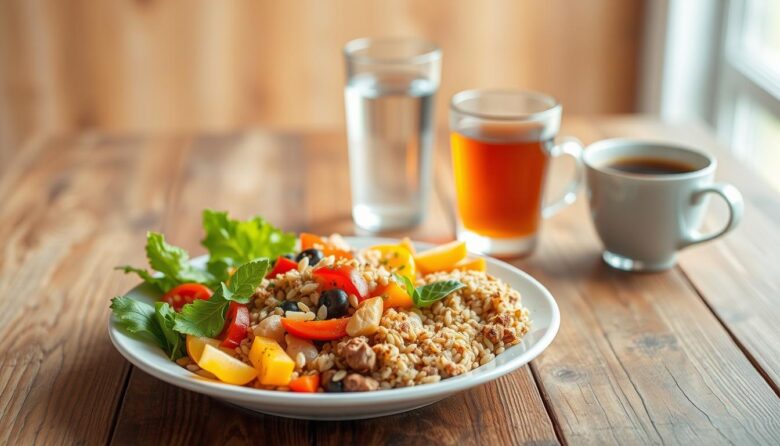Maintaining good eating habits becomes more crucial as we age. A balanced diet helps older individuals stay strong, energized, and independent. It supports physical health while reducing risks linked to chronic conditions like heart disease and weakened bones.
Many face obstacles that disrupt regular meal patterns. Changes in taste perception, medication side effects, and limited mobility can make food preparation difficult. Social factors like eating alone or fixed budgets often complicate choices further.
Small adjustments to daily routines can create meaningful improvements. Simple strategies like prioritizing nutrient-rich snacks or setting hydration reminders address common challenges effectively. These changes help preserve muscle mass and mental clarity while promoting overall wellness.
This guide explores practical ways to adapt to shifting needs during later life stages. Discover how to overcome barriers through meal planning techniques and creative solutions tailored for aging bodies. Learn why staying hydrated matters just as much as food quality for maintaining vitality.
Embracing Healthy Eating Habits
Our bodies evolve with time, requiring smarter food choices to stay vibrant. While calorie needs often decrease after 50, the demand for essential vitamins and minerals increases sharply. This shift makes nutrient density critical – getting more nourishment from every bite.
Understanding Nutrient Needs as You Age
Bone-strengthening calcium and vitamin D become vital as absorption efficiency declines. Adults over 51 need 400 IU of vitamin D daily, often requiring supplements. Iron and B12 levels also warrant attention due to natural metabolic changes.
Diversifying Foods for Optimal Health
Colorful plates deliver diverse nutrients. Try dark greens like kale three times weekly and orange veggies like carrots every other day. Whole grains such as oats provide sustained energy, while proteins like eggs and beans maintain muscle mass.
Experiment with rosemary or turmeric instead of salt if flavors fade. Vary temperatures – try chilled cucumber salads alongside warm lentil soups. These adjustments keep meals interesting while meeting changing dietary needs.
nutrition tips for seniors
Fueling the body effectively in later years starts with practical adjustments to daily routines. Focus on meals that deliver maximum benefits without complex preparation. Fresh ingredients and smart planning simplify maintaining a balanced diet.
Actionable Steps for Daily Nutritional Improvements
Build meals around the Healthy Eating Plate model: Fill 50% of your dish with colorful vegetables, 25% with whole grains like quinoa, and 25% with proteins like grilled chicken. This structure ensures diverse nutrients per serving.
Swap processed snacks with whole foods like apple slices or almonds. These options stabilize energy levels and reduce blood sugar spikes. Batch cooking soups or roasted vegetables saves time while keeping portions ready.
Shop frozen fruits and vegetables when fresh options aren’t practical. They retain vitamins and minimize waste. Pair carb-rich foods with proteins – try whole-grain crackers with hummus – for sustained vitality throughout the day.
Keep a water bottle visible during meals to support hydration. Small, frequent adjustments create lasting habits that enhance overall well-being without overwhelming changes.
Mastering Hydration for Vital Health
Staying adequately hydrated plays a critical role in supporting bodily functions and cognitive health. As we age, the body’s thirst signals weaken, making consistent fluid intake essential even when not feeling thirsty. The National Academy of Medicine advises 9-13 cups of fluids daily for adults, emphasizing water as the primary source.
Creative Ways to Stay Hydrated Throughout the Day
Infuse water with cucumber or berries for natural flavor. Herbal teas and low-sodium broths count toward daily goals while adding variety. Incorporate hydrating foods like watermelon or spinach, which contain over 90% water.
Set hourly reminders using phone alerts or sticky notes. Keep a marked water bottle visible to track progress. For those avoiding frequent bathroom trips, smaller sips spread evenly work better than large quantities at once.
Include milk or fortified plant-based drinks with meals for added calcium. Frozen fruit chunks make refreshing snacks that boost fluid intake. Monitor urine color – pale yellow indicates proper hydration, especially during heat or illness.
Overcoming Challenges in Meal Preparation & Cooking
Meal preparation can become unexpectedly complex as lifestyles change. Cooking for smaller groups often leads to leftovers or wasted ingredients. Physical limitations and fluctuating energy levels add layers of difficulty to daily food routines.
Adapting Recipes for Changing Tastes and Abilities
Simplify favorite dishes by using pre-cut vegetables or slow cooker methods. Soften textures through steaming or blending for easier chewing. Boost flavors with citrus zest or smoked paprika if taste perception fades.
Cook double portions of soups or casseroles on high-energy days. Freeze extras in single-serving containers for quick reheating. Keep pre-washed greens and rotisserie chicken handy for no-cook meals.
Utilizing Community Resources for Meal Support
Many organizations offer grocery delivery or group meal programs. Local senior centers often host cooking classes tailored to limited mobility. Meal delivery services like Meals on Wheels provide balanced options with minimal effort.
Partner with neighbors for ingredient swaps or shared cooking days. Check community bulletin boards for volunteer shopping assistance. These resources save time while ensuring access to nourishing food choices.
Building a Balanced Diet: Protein, Fiber & Vitamins
A well-rounded diet becomes a cornerstone of vitality as we grow older. Strategic combinations of protein, fiber, and essential vitamins help combat muscle loss and support long-term wellness. These nutrients work together to maintain strength, digestive health, and cellular function.
Essential Sources of Protein and Fiber
Adults can lose up to 50% of muscle mass between ages 40-80. A 150-pound person needs 68-83 grams of protein daily. Spread intake across meals with 25-30 grams per serving for optimal absorption.
Animal-based options like fish, poultry, and low-fat dairy provide complete proteins. Plant alternatives include lentils, beans, and quinoa. Pair these with fiber-rich fruits or whole grains to slow digestion and enhance nutrient uptake.
Gradually increase fiber to 21-30 grams daily using apples, almonds, and cabbage. This reduces heart disease risks while easing bowel movements. Start with small portions to prevent bloating.
Vitamins and Minerals in Healthy Aging
Key nutrients become harder to absorb with age. Vitamin D supports bone health, while B12 maintains nerve function. Leafy greens and fortified cereals offer these vitamins naturally.
Include calcium-rich foods like yogurt and sardines. Iron from spinach and lean meats combats fatigue. Focus on whole foods before considering supplements to ensure balanced minerals intake.
Preventing Chronic Diseases with Smart Food Choices
Smart dietary decisions can significantly lower the likelihood of developing long-term health issues. Processed foods often contain hidden dangers that strain the body over time. Learning to identify and replace these items helps protect against conditions affecting heart health and metabolic balance.
Managing Salt, Sugar, and Processed Food Intake
Excess sodium disrupts blood pressure regulation, increasing risk heart disease by 20-30%. The American Heart Association advises limiting daily sodium to 1,500 mg – roughly ¾ teaspoon. Check labels for sneaky sources like bread, canned soups, and deli meats.
Swap salt with lemon zest or garlic powder for bold flavors. Frozen vegetables without sauces offer convenience without added sodium. When craving sweets, try cinnamon-dusted apple slices instead of sugary snacks.
Processed items often combine high sugar, unhealthy fats, and preservatives. These ingredients trigger inflammation linked to disease development. Choose whole-grain crackers over chips, or air-popped popcorn instead of pretzels.
For those managing diabetes or hypertension, meal timing matters. Pair carb-rich foods with proteins to stabilize blood sugar. Roasted chickpeas make a crunchy, low-sodium alternative to salted nuts.
Budget-Friendly Shopping and Meal Planning Strategies
Eating well shouldn’t strain your wallet. Fixed incomes often require creative solutions to balance quality and cost. Smart planning and available resources help maintain variety without overspending.
Leveraging SNAP and Other Assistance Programs
The Supplemental Nutrition Assistance Program (SNAP) helps eligible individuals buy foods like fruits, vegetables, and whole grains. Benefits now work with online grocery services at Walmart, Amazon, and major delivery apps. Check state guidelines to confirm eligibility based on income and household needs.
Local agencies often assist with applications. Once approved, make sure to use benefits for nutrient-rich options first. Many stores double SNAP dollars at farmers markets for fresh produce.
Tips for Planning Affordable, Nutritious Meals
Build meals around weekly sales and seasonal items. Canned beans and frozen veggies offer similar nutrients to fresh at lower costs. Buy rice, oats, and spices in bulk – these staples last months and cost less per day.
Join store loyalty programs for personalized coupons. Shop on senior discount days (often 5-10% off). Split large bulk purchases with neighbors to reduce waste. Pre-portion snacks like nuts or dried fruit to avoid overspending on prepackaged items.
Consider community resources like grocery buses or meal kits from local centers. These services address mobility challenges while meeting dietary needs. With thoughtful strategies, nourishing foods become both accessible and sustainable.
Wrapping Up Your Journey to Better Nutrition
Adopting sustainable food practices remains vital at any stage of life. Prioritizing calcium-rich foods like low-fat milk and leafy greens supports bone strength, while colorful fruits and vegetables deliver essential vitamins for energy and immune function.
Stock emergency supplies with nutrient-dense options: canned salmon for protein, whole-grain pasta for fiber, and frozen berries for antioxidants. These choices maintain health during unexpected situations without sacrificing quality.
Small, consistent changes create lasting benefits. Swap sugary drinks for herbal teas or infused water to reduce sodium and sugar intake. Pair lean proteins with complex carbs at meals to stabilize blood sugar and preserve muscle mass.
Every positive choice strengthens your body against age-related challenges. Whether adjusting portion sizes or exploring new recipes, each step enhances vitality and independence through thoughtful healthy eating habits.



